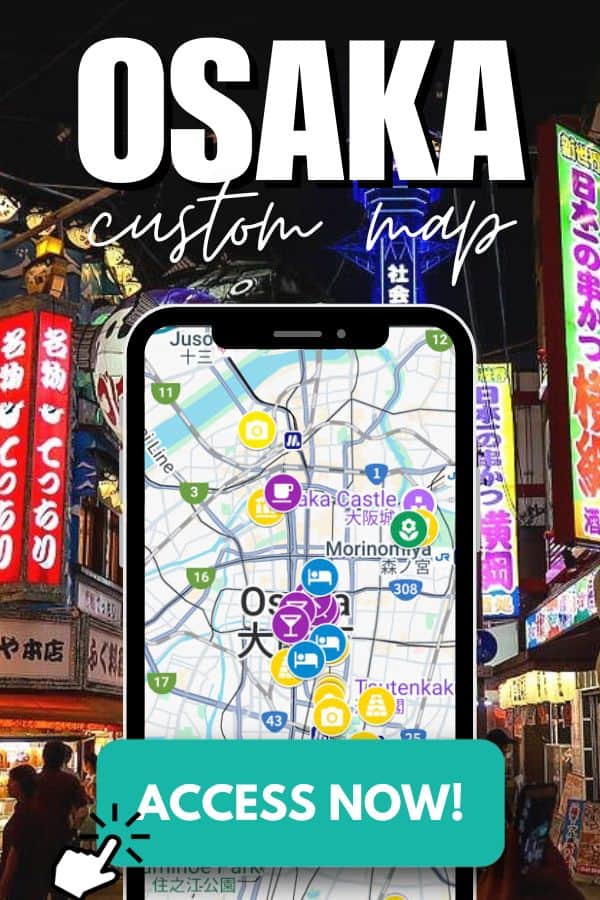With lots of accommodation and transportation options, Osaka makes a perfect home base for exploring this part of Japan. These day trips from Osaka are packed with history, culture, nature, and culinary adventures, all within a couple hours of the city.
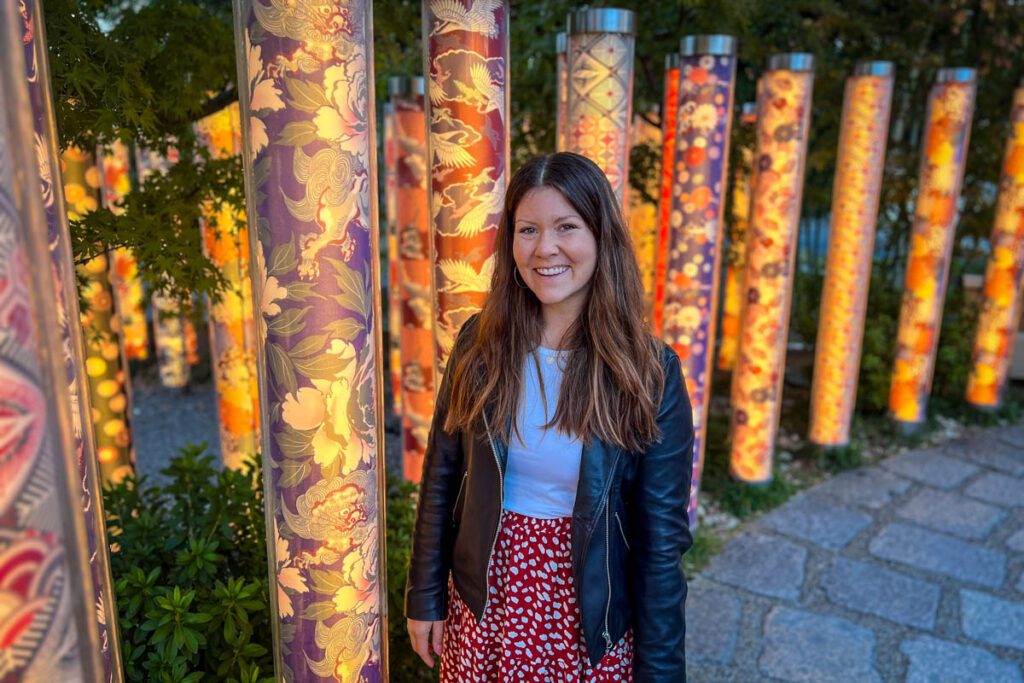
As Japan’s third largest city, Osaka earns a top spot on many traveler’s itineraries. And with its vibrant nightlife, abundant street food, and laid-back locals, there are so many exciting things to do in Osaka that you could easily spend your whole trip here.
But if you’re visiting Osaka, we highly recommend taking advantage of Japan’s world-class transportation infrastructure to explore further. Ancient cities, woodland temples, floating castles, and therapeutic hot springs are just a hop, skip, and jump away.
For each of these day trips from Osaka, we’re listing the top sights and activities to base your itinerary on. We’re also giving directions, whether you’re using public transportation or you have your own set of wheels.
Day trips from Osaka
- Minoo Park
- Kyoto
- Hiroshima
- Nara
- Himeji Castle
- Kobe
- Koyasan/Kumano Kodo
- Arima Onsen
- Takeda Castle ruins
- Lake Biwa
- Ikeda
- Uji
- Wakayama
- Nagoya
- Mt Rokko
- Awaji Island
And if you’re wondering how to get to all these awesome places, jump down to the transportation section.
1. Minoo Park

- At a glance: Lush park with walking path to a stunning waterfall
- Distance from Osaka: 20.7 km / 12.9 miles
- Time: 45 minute train ride / 27 minutes driving
After a couple days of weaving through crowded city streets in Osaka, we were craving some time in nature. We did a little research and found that just 45 minutes north of the city center sits a nature lover’s oasis.
With a paved walking path that leads through forested mountains to a waterfall, this park is a popular spot for local couples and families to escape city life for part of a day.
We visited Minoo on a holiday weekend, and while it was busy with locals, it wasn’t too crowded. Plus, we only spotted a handful of other foreigners, so it felt more like a hidden gem and less like a tourist trap.
Good to know: It’s free to enter the park, but the train to get to Minoo Park is not covered in the JRail Pass. A return trip from Osaka Station costs 540 yen per person. You’ll also want to budget a bit of money for lunch or snacks along the way.
Top things to do in Minoh Park
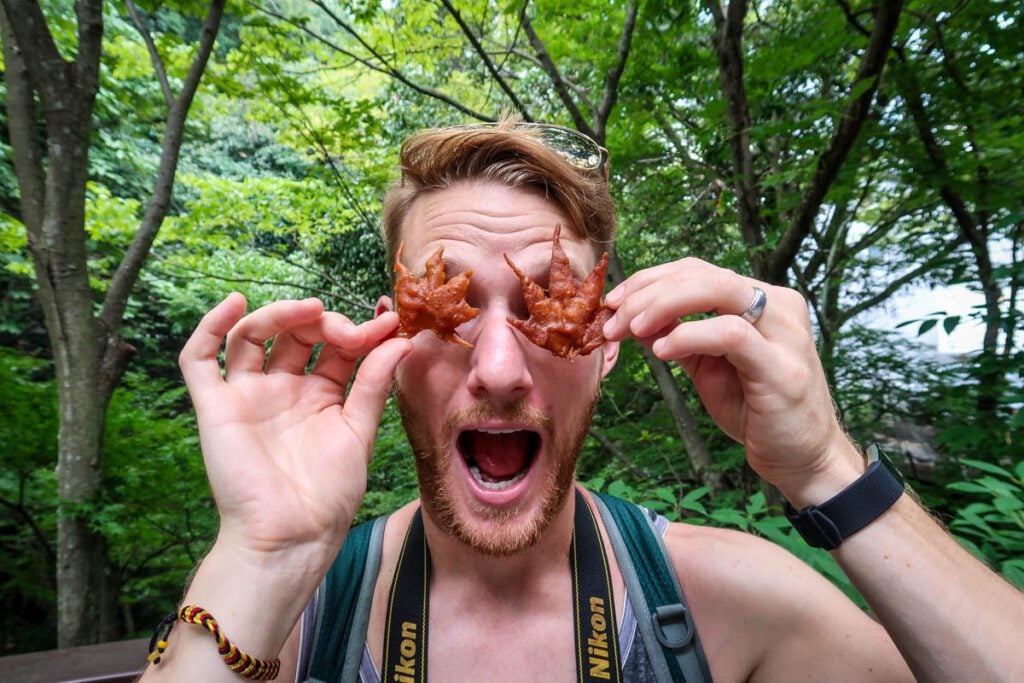
We have a complete Minoo Park day trip guide, but here are few top highlights:
- Follow the path to Minoo Waterfall. The paved walking path is mostly flat(ish), making it a great option for families with small children and strollers. It takes around 45 minutes to get to the waterfall, which marks the end of the path. You’ll find snack vendors as well as a few restrooms along the way.
- Try momiji tempura, aka deep-fried maple leaves. The leaves themselves don’t really have a flavor, while the batter is very crunchy and just a little sweet. They’re fun to try!
- We’d recommend finding a stand where they are making them fresh instead of just buying a bag on display.
- Explore Ryuan-ji Temple, a peaceful Buddhist site known as the birthplace of the lottery in Japan.
- Choose a more challenging hiking trail that takes you off the paved walking path and deeper into the forest.
- Discover the insectarium, a small museum showcasing a diverse collection of both biological specimens and living insects, including a butterfly garden.
How to get there
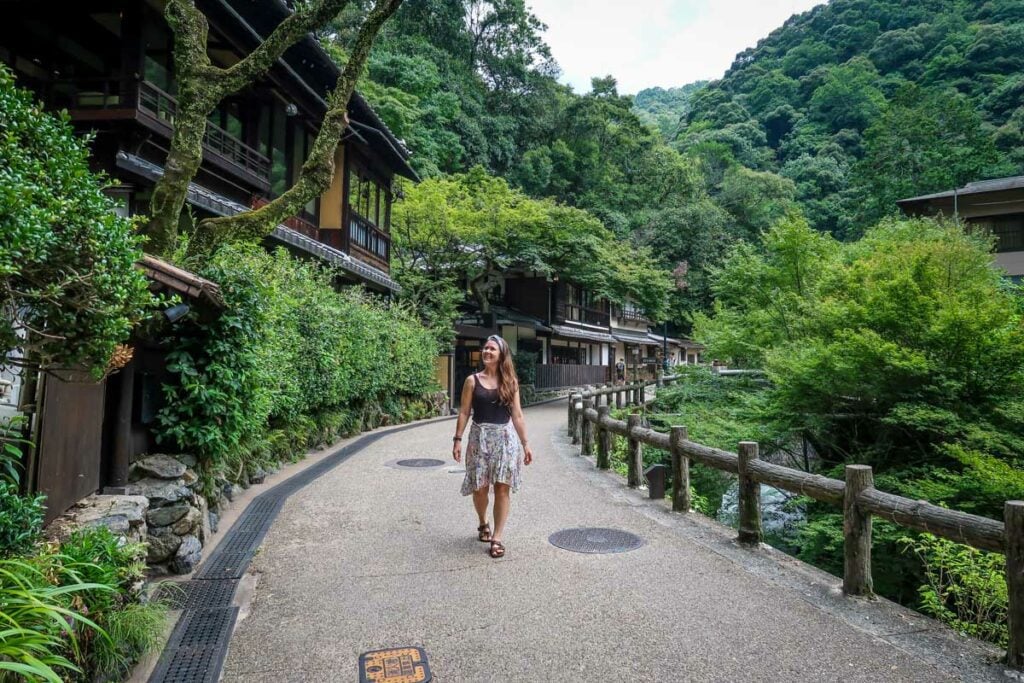
By train: From the Osaka-Umeda Station (near Osaka Station), take the Hankyu-Takarazuka Line (best if it is the Express Train because it makes fewer stops). Change trains at Ishibashi Handai-mae Station and get on the Hankyu-Mino Line heading to Minoo. The whole trip takes about 45 minutes.
By car: It’s a very straightforward drive from Osaka to Minoh Park via Route 423. Take the left exit at Hakushima 2-chōme intersection and follow signs for Route 43 toward Katsuoji Temple/Mino Park.
→ Psst! Check out our ultimate 2 day Osaka itinerary, which includes a trip to Minoh Park and has all the planning done for you so you can relax and enjoy your trip!
2. Kyoto

- At a glance: Cultural capital of Japan with tons of famous sights
- Distance from Osaka: 55.6 km / 34.5 miles
- Time: 13 minute train ride / 54 minutes driving
Kyoto is one of the most popular cities to visit in Japan, and for good reason.
With historic districts like Gion and Higashiyama, famously beautiful streets like Pontocho Alley, and iconic landmarks like Arashiyama Bamboo Forest and the Fushimi Inari gates, a day trip to Kyoto deserves a spot on your itinerary.
→ Psst! Are you trying to choose whether to stay in Osaka or Kyoto? Both are worth it if you have the time. But if you can only pick one, our Kyoto vs. Osaka guide can help you decide!
Top things to do in Kyoto
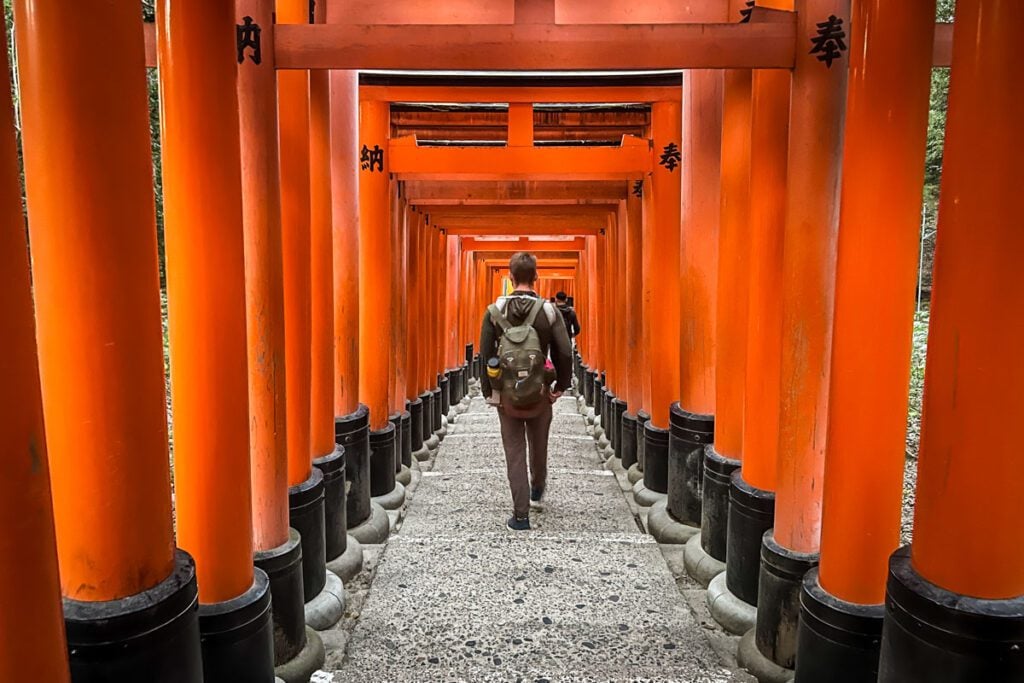
We have a whole guide to the best things to do in Kyoto, but here are a few highlights that can easily be done on a day trip:
- See the orange gates of Fushimi Inari Shrine, one of the most iconic sights in Japan. Following the pathway through thousands of orange torii gates as sunlight streams through the spaces between them is a truly magical experience that we can’t quite describe.
- Explore the historic districts of Gion and Higashiyama. Gion is famously known as the “Geisha District” and one of the best places to spot the renowned Japanese performance artists. Higashiyama is perhaps the best preserved part of Kyoto, full of traditional wood shops, cafes, and restaurants.
- Wander through Arashiyama Bamboo Forest, a grove of towering bamboo stalks that sway ever so slightly in the breeze, creating an otherworldly atmosphere.
- Insider Tip: This bamboo grove nearby is smaller but way less crowded, and we actually liked it better!
- Walk the Philosopher’s Path, a trail of stone steps laid by Japan’s famed philosopher, Nishida Kitaro, which connects the temples of Ginkaku-ji (Silver Pavilion), Eikan-do/Zenrin-ji, and Nanzen-ji.
- Photograph the famous Kinkaku-ji (Golden Pavilion), a dazzling Buddhist temple covered in gold leaf and set in a beautiful lakeside garden.
→ Want to extend your day trip? We have an itinerary for 2 days in Kyoto that will allow you to see top sights as well as hidden gems in this magical city!
How to get there
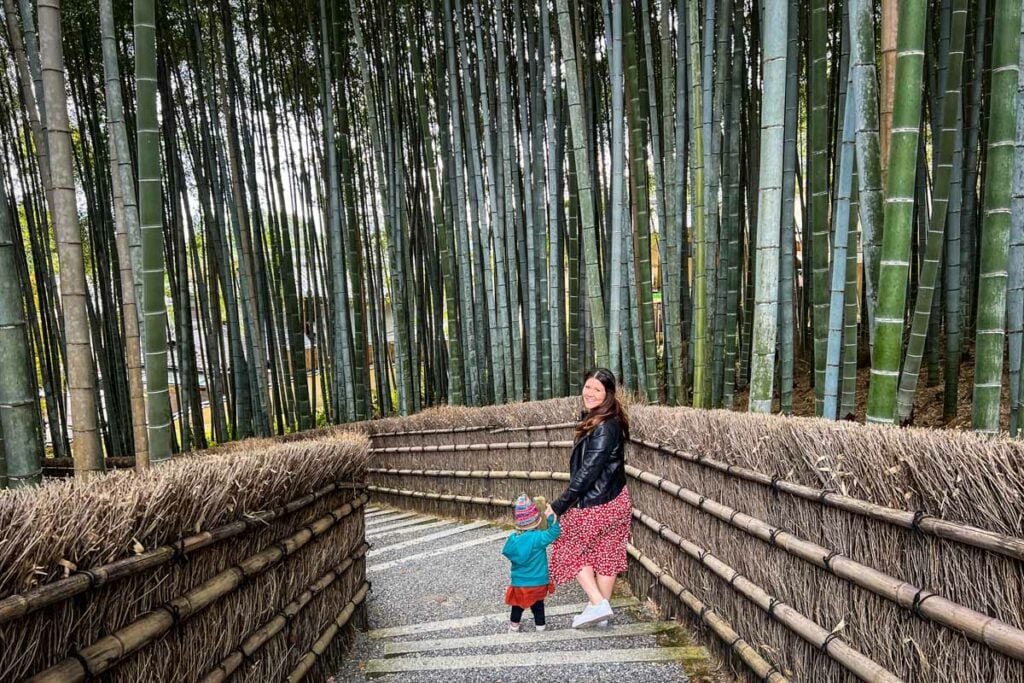
By train: The quickest way to get from Osaka to Kyoto is on the Tokaido-Sanyo Shinkansen–Nozomi 200 Nozomi Tokyo, which departs from Shin-Osaka Station every 9 minutes and takes only 13 minutes to arrive at Kyoto Station. Individual fare is ¥3,280 (~$22 USD), or free with your JR Pass. Alternatively, the regular Tokaido-Sanyo Line takes 42 minutes and costs ¥580 (~$4 USD).
By car: There are a couple of different routes you can take from Osaka to Kyoto and they both take roughly 50-55 minutes.
- Take Route 13 out of Osaka and get on the Dainikeihan Expressway, following signs for Hirakata/Kyoto City.
- Take Route 11 out of Osaka and follow the Meishin Expressway to Kyoto City.
By guided tour: This highly-rated tour is packed with Kyoto’s top highlights, including Fushimi Inari Shrine, the Golden Pavilion, and Arashiyama Bamboo Forest. Enjoy a traditional Kyoto tofu dish for lunch included in your tour.
3. Hiroshima

- At a glance: Vibrant city with tragic historical significance
- Distance from Osaka: 336 km / 209 miles
- Time: 1 hour 25 minute train ride / 4.5 hours driving
Just under 1.5 hours from Osaka by train, Hiroshima is one of the most impactful day trips you can take in Japan.
While its name is forever tied to the tragic events of WWII, the city today is vibrant, peaceful, and full of hope. It has a slower, more reflective pace than Osaka, and walking through its parks and memorials is a moving experience that’s hard to put into words.
As you can imagine, this is heavy stuff. But it’s incredibly important for people to see places like this in order to better understand our world history, to pay respects to lives lost, and to move forward without repeating the mistakes of our past.
If you have extra time, we highly recommend exploring more of the city. Hiroshima has a palpable energy and a spirit of resilience that is deeply moving, and there are lots of fun things to do.
Top things to do in Hiroshima
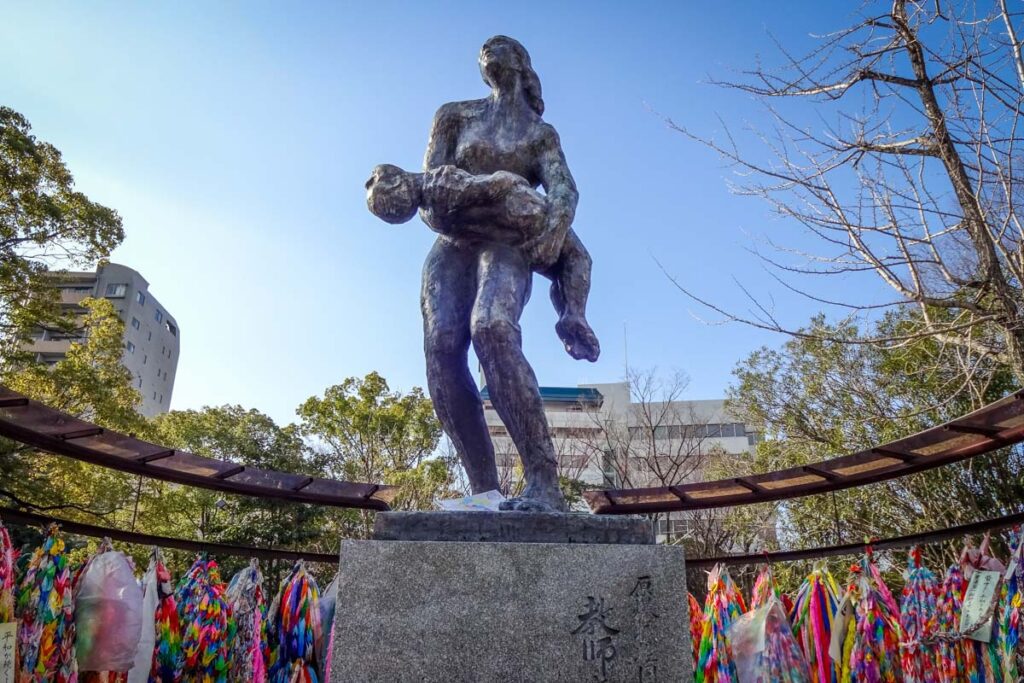
We have a detailed guide for the perfect Hiroshima day trip from Osaka, but here are a few top recommendations:
- Visit the Hiroshima Peace Memorial Museum and learn all about the devastation caused by the atomic bomb.
- Tour Hiroshima Peace Park. This open-air park is dedicated to all victims of the atomic bomb and contains a number of monuments, art installations, and memorials.
- Pay your respects at the Children’s Peace Monument, filled with paper cranes and dedicated to all the children who lost their lives to the attack.
- See the Atomic Bomb Dome, one of the only structures left standing after the blast.
- Try Hiroshima-style okonomiyaki, which is quite different from the traditional Osaka version.
- Insider Tip: Nagataya makes the best okonomiyaki and is conveniently located just steps away from the Peace Park.
- Explore Hiroshima Castle, a replica of the 1590s original (which was destroyed by the atomic bomb). You can wander the grounds for free, or pay ¥370 (~$2.50 USD) to enter the keep, which contains museum exhibits and an observation deck.
- Take the ferry to Miyajima Island. Known for its picturesque “floating” torii gate, wild deer, and views from Mount Misen, this small island is worth a visit. Bonus: the ferry to Miyajima Island is covered by the JR pass!
How to get there

By train: The quickest way to get from Osaka to Hiroshima is on the Tokaido-Sanyo Shinkansen–Mizuho 601 Mizuho Kagoshimachuo, which takes about 1 hour 25 minutes from Shin-Osaka Station to Hiroshima Station. Individual fare is ¥11,150 (~$74 USD), or free with your JR Pass.
By car: If you have a rental car in Japan, you’ll have a straightforward journey from Osaka to Hiroshima via major highways and expressways. The drive is about 4 hours and 40-45 minutes one-way.
By guided tour: Travel by bullet train to Hiroshima and tour the city by bus on this guided day trip. Visit the Hiroshima Peace Memorial Museum and other important historical sites before enjoying specialty okonomiyaki for lunch. Afterwards, explore the island of Miyajima before returning to Osaka.
4. Nara
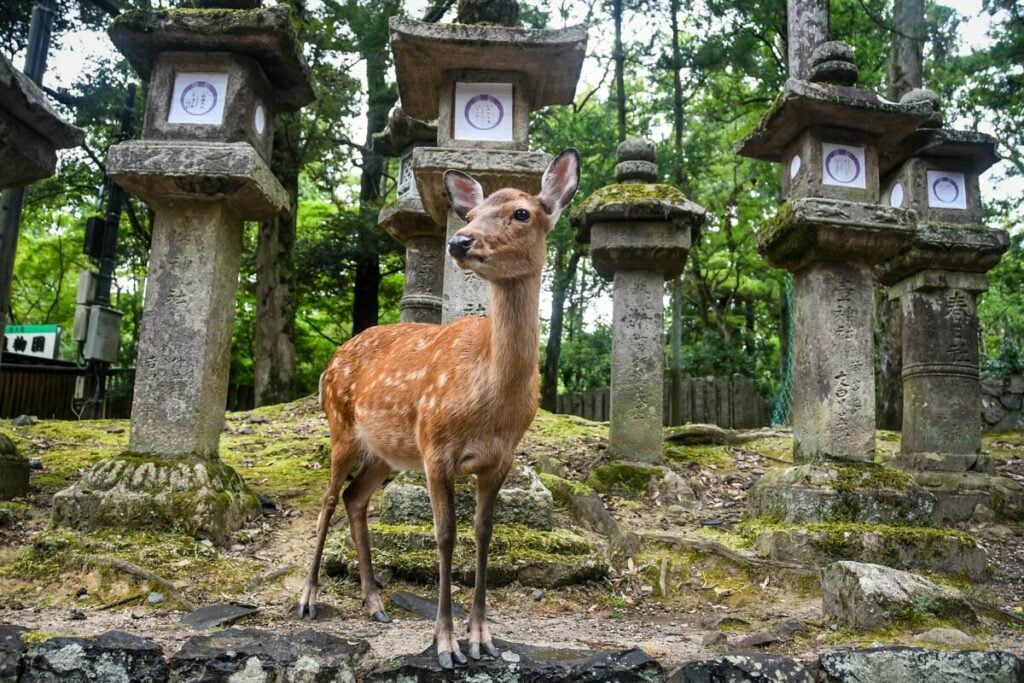
- At a glance: Ancient capital famous for its wild deer population
- Distance from Osaka: 32 km / 20 miles
- Time: 50 minute train ride / 31 minutes driving
Nara is a region full of cultural treasures. The city was the first capital of Japan from the years 710 to 794 and there are plenty of stunning temples and shrines to explore.
But the main reason tourists flock to Nara is for the adorable, friendly deer that populate the city. Believed to be messengers of the gods in the traditional Shinto religion, the Sika deer are considered sacred and are allowed to roam freely among the city streets, parks, and temples.
Top things to do in Nara
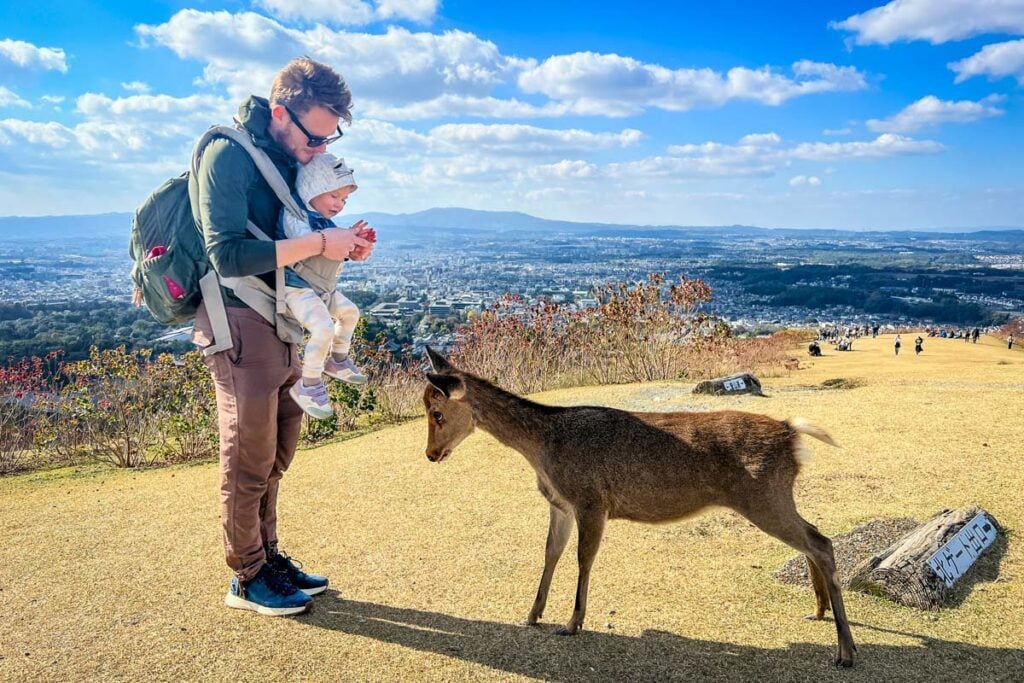
We’ve curated the perfect Nara day trip itinerary, including these highlights:
- Meet the famous “bowing deer” at Nara Park. The 1,000-plus small, spotted Sika deer that live within the Nara city limits are not shy of humans, and you’ll feel like a real-life Disney princess with them following you around.
- Get off the main walking street and explore deeper into Nara’s parks and temples, where you’ll find fewer crowds and deer that aren’t surrounded by selfie sticks.
- Crawl through “Buddha’s Nostril” at Tōdai-ji Temple. The hole carved through the pillar is supposedly the same size as Buddha’s nostrils on the bronze statue for which this temple is famous. Crawling through is said to bring enlightenment in the next life.
- Try freshly-made mochi at the famous Nakatanidou.
- Visit a Japanese garden. We recommend Yoshikien Garden, as it is free for all foreign visitors. It’s located next to the larger and more famous Isuien Garden, which is particularly beautiful in autumn.
- Explore Naramachi, an area in town where streets retain their historic charm.
How to get there

By train: The most direct route from Osaka to Nara is via the Osaka Loop Line–Yamatoji-Rapid Nara, which departs Osaka Station every 15 minutes. Stay on the same train until you reach Nara Station (about 50 minutes / 12 stops). The fare is ¥820 (~$5 USD).
By car: Osaka to Nara is an easy 30-minute drive via Routes 13 and 163.
By guided tour: This sightseeing tour from Osaka makes stops in both Kyoto and Nara. In Nara Park, you’ll have a chance to meet the famous wild deer and explore Todai-ji Temple. This tour also includes a buffet or beef shabu shabu lunch.
5. Himeji Castle
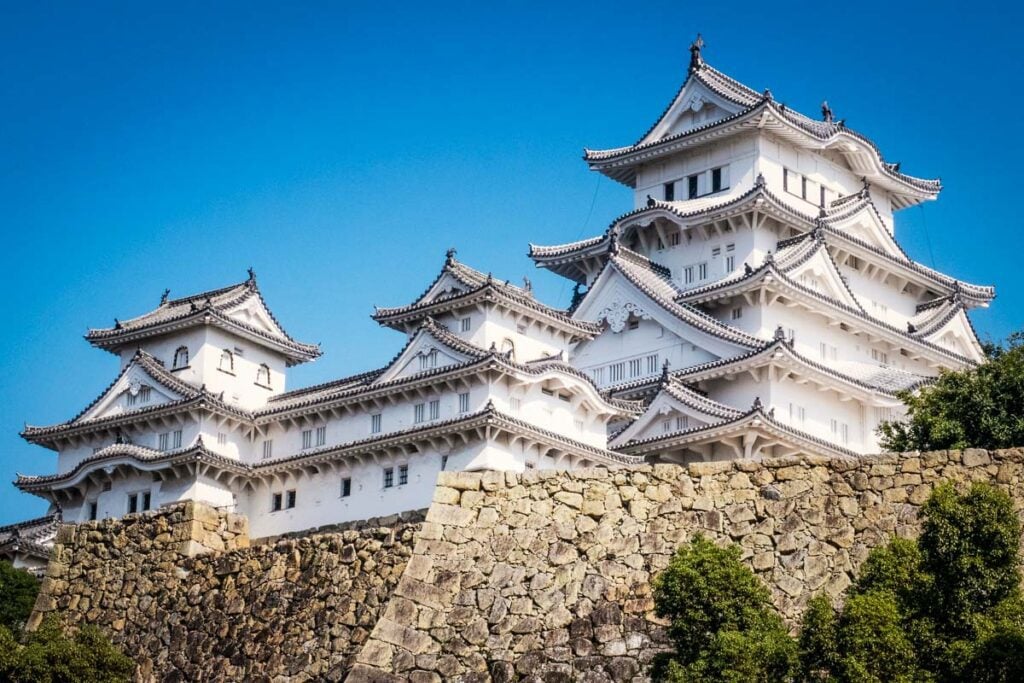
- At a glance: Hilltop complex widely recognized as Japan’s most spectacular castle
- Distance from Osaka: 94.4 km / 58.7 miles
- Time: 47 minute train ride / 1 hour 18 minutes driving
Known as one of Japan’s 12 original castles as it was never destroyed by earthquake, war, or fire, Himeji Castle is both a National Treasure and World Heritage Site.
It’s nicknamed the “White Heron Castle” due to its elegant white exterior and how it takes on the appearance of a bird taking flight.
The grounds consist of 83 buildings and more than a thousand cherry trees, making it a renowned location for hanami (flower-viewing) in the early spring.
If you come for the cherry blossoms, be prepared for crowds. If your main goal is to explore the castle, we’d recommend visiting outside of sakura season to avoid wait times.
Good to know: A thorough visit through the castle takes 3-4 hours. Admission is ¥1,000 (~$6.75 USD) for the castle or ¥1,050 for both the castle and Kokoen Garden.
Top things to do in Himeji Castle

- Explore the castle keep. The 600-year-old seven-story castle offers spectacular views over Himeji from the top floor. Take a tour or make sure you have a map on hand – the labyrinth of passages connecting the castle buildings was specifically designed to confuse enemy intruders.
- Wander through Kokoen Garden. This series of 9 separate, walled gardens display different styles of the Edo period. The reflecting ponds, cascading waterfalls, swaying bamboo, and colorful flowers create a serene atmosphere that beautifully illustrates the changing of Japan’s seasons.
- Glide around the castle’s inner moat in a traditional Japanese boat. Boat tours are seasonal and operate only on weekends.
How to get there
By train: You can either take the Tokaido-Sanyo Line Special Rapid Himeji or the Tokaido-Sanyo Shinkansen from Shin-Osaka Station to Himeji Station. The regular train costs ¥1,520 (~$10 USD) and takes 1 hour 8 minutes, while the bullet train takes 28 minutes and costs ¥4,130 (~$28 USD).
From Himeji Station to the castle is about a 20 minute walk, or you can take a local bus.
By car: The drive from Osaka to Himeji Castle is about 1 hour and 18 minutes via major highways and expressways.
By guided tour: Entry to Himeji Castle is included in this tour, which combines 3 of the top day trips from Osaka for a jam-packed day of sightseeing.
6. Kobe
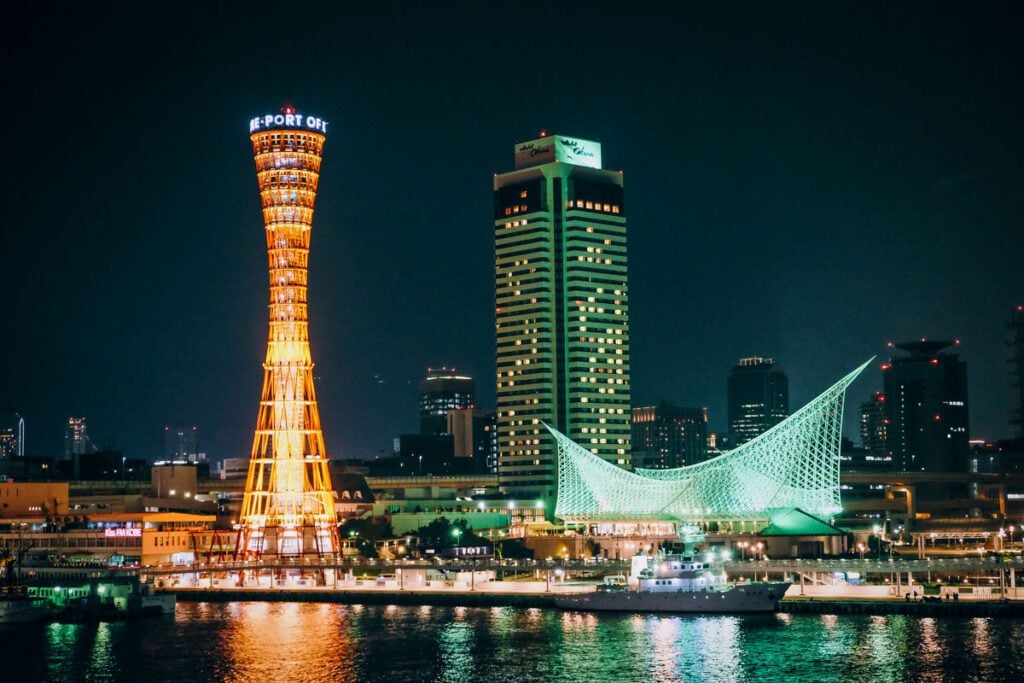
- At a glance: Cosmopolitan port city home to world-famous beef
- Distance from Osaka: 33.6 km / 21 miles
- Time: 12 minute train ride / 33 minutes driving
Situated between the mountains and the bay, the port city of Kobe is one of the most convenient day trips from Osaka.
Kobe is best known, of course, for its namesake beef, infamous for its high price tag. Strictly regulated by the Japanese government, fewer than 4,000 cattle meet the requirements to earn the name “Kobe beef” each year. A steak at a premium restaurant can cost as much as ¥30,000 – a whopping $200 USD. That’s a lot of moo-la (see what I did there?)!
Though often overshadowed by the bougie beef, Kobe also produces a quarter of the country’s sake. Japan’s famous rice alcohol can be served hot or cold and can cost anywhere from ¥1,500 to ¥10,000 ($10-70 USD).
Top things to do in Kobe
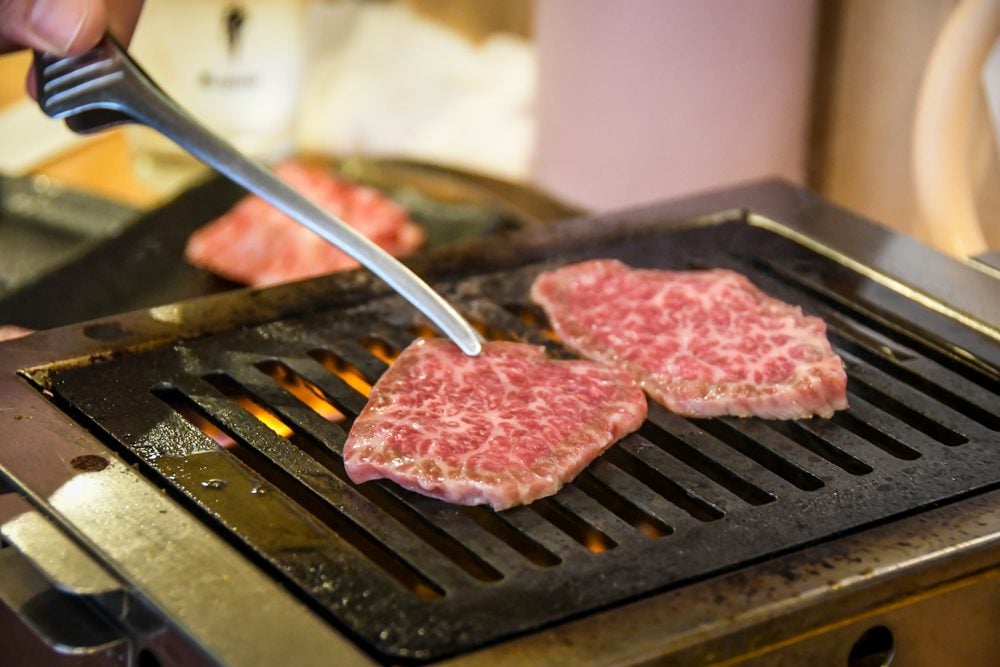
- Indulge in the famous Kobe beef.
- Insider Tip: Look for restaurants with lunch menus, as they’re often cheaper than dinner.
- Glimpse the iconic Kobe Port Tower. Though currently closed for renovations with plans to reopen in 2025, you can still enjoy the sight of the tower that defines Kobe’s skyline.
- Cruise Kobe Bay. There are several cruise operators around the port that offer boat tours around Kobe Bay.
- Ride the ropeway to Nunobiki Herb Gardens. This hillside oasis has 12 gardens showcasing about 200 varieties of herbs and flowers, totaling more than 75,000 blooms. Enjoy experiences like making your own fragrance or herb sachet, or soaking in a herbal footbath.
- Hike to Nunobiki Falls. About halfway up to the herb gardens, the Nunobiki Ropeway passes over a series of cascading waterfalls. There’s a hiking trail you can take back down past the falls to Shin-Kobe Station (as long as you’re not carrying too many herb souvenirs). The trail is about 1.7 km one-way and takes about 30 minutes.
- Taste sake in Nada-Gogo, one of the best-known sake regions in Japan that has been in the game for almost 7 centuries. Lots of the sake breweries offer tastings and tours, sometimes with English options.
- Wander the historic Kitano district, an area with well-preserved Western-style residences and stylish cafes and restaurants. This area highlights the city’s international influence.
- Score some deals at Sanda Outlets, a collection of factory stores from popular brands and high-end designers.
How to get there
By train: The quickest way to get from Osaka to Kobe is on the Tokaido-Sanyo Shinkansen going toward Mizuho 601 Mizuho Kagoshimachuo. It takes only 12 minutes from Shin-Osaka Station to Shin-Kobe Station and the fare is ¥3.470 (~$23 USD), or free with your JR Pass. Alternatively, the Tokaido-Sanyo Line–Local Nishi-Akashi train from Osaka Station to Sannomiya Station is 35 minutes for ¥420 (~$3 USD).
By car: Take Route 3 heading north out of Osaka. Stay on Route 3 all the way to Kobe.
By guided tour: Experience the highlights of Kobe on this full-day tour. Wander the seaside promenade at Kobe Port and take in the historical architecture of Kitano Ijinkan Street. This robust tour also includes visits to Arima Onsen and Mount Rokko (#7 and #14 on this list of day trips from Osaka).
7. Koyasan / Kumano Kodo
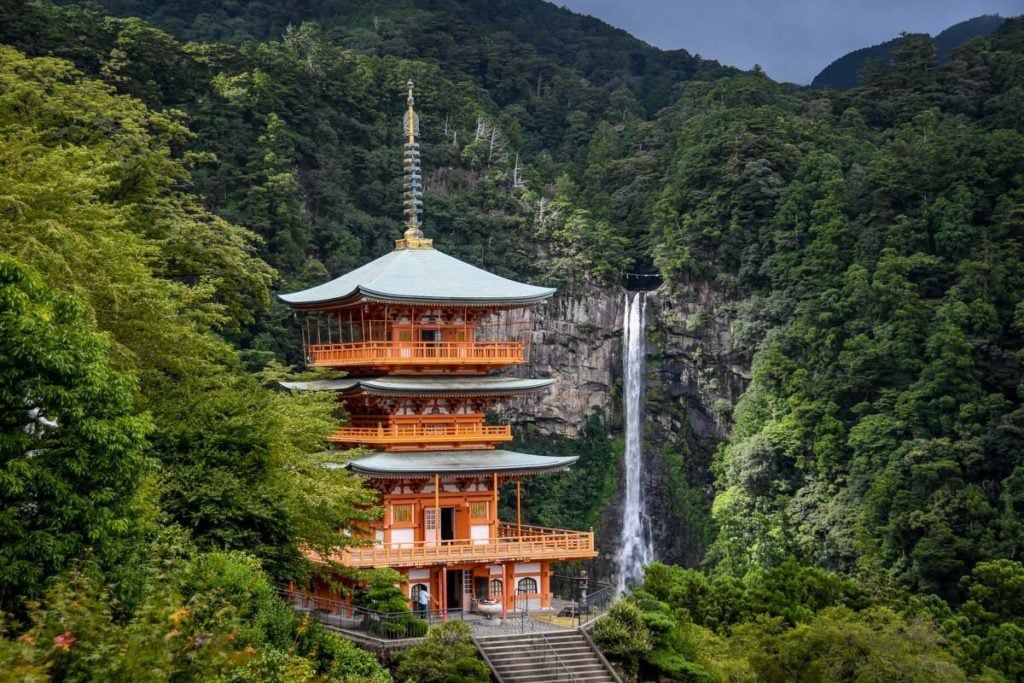
- At a glance: Sacred mountain and starting point of Japan’s ancient pilgrimage trail
- Distance from Osaka: 89.4 km / 55.6 miles
- Time: 2 hour train ride / 1 hour 33 minutes driving
Koyasan (or Mount Koya) is a secluded temple town nestled in the mountains of the Kii Peninsula. Dotted with ancient Buddhist relics, vegetarian eateries, and temple stays, a day trip to Koyasan offers a peaceful escape from bustling Osaka.
Koyasan serves as a gateway to the Kumano Kodo, an ancient pilgrimage trail that brings hikers to small villages, past picturesque farmsteads and historic shrines, and through giant cedar forests.
The Kumano Kodo is utterly enchanting and one of our absolute favorite things we’ve done in Japan (and we’ve been here 3 times!). You won’t be able to do the whole hike on a day trip, but if you’re intrigued and want to know more, check out our full Kumano Kodo guide.
Top things to do in Koyasan / Kumano Kodo
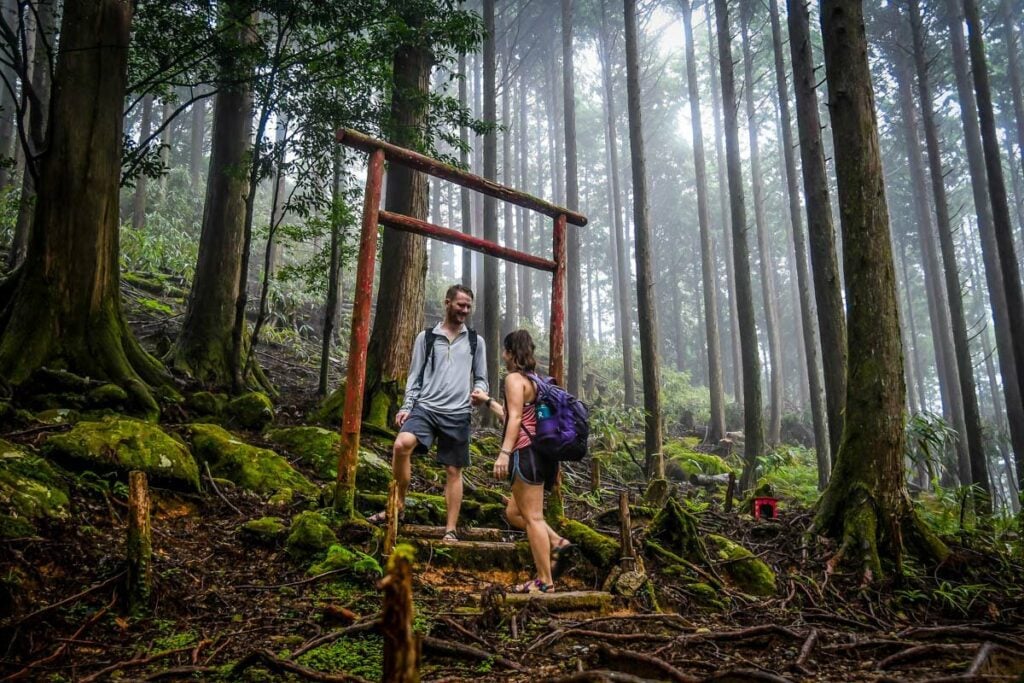
- Hike Kumano Kodo, an ancient pilgrimage trail that weaves through remote mountains and tiny villages where you can stay at traditional guesthouses. (Again, not day trip material, but soooo worth an extra few days in your itinerary!)
- Extend your visit to include a temple stay. FYI, a “temple stay” doesn’t exactly mean staying with monks; it’s more or less a stay at a ryokan with Buddhist vegetarian meals and a chance to observe monks in their morning ritual. Still a memorable experience!
- Explore Okunoin Cemetery, the largest cemetery in Japan and the holiest site in Koyasan. Hundred year old cyprus trees and more than 200,000 tombstones line the path to where Kobo Daishi (the founder of Shingon Buddhism) rests in eternal meditation.
- Visit Kongobu-ji, the head temple of Shingon Buddhism and location of Banryutei, Japan’s most expansive rock garden.
- Participate in Buddhist ceremonies and practices, such as meditation, forest therapy, flower arrangement, or shakyo (hand-copying scripts called sutras).
- Savor the unique culinary experience of shojin ryori, the vegetarian cuisine of Buddhist monks.
How to get there

By train: To get to Koyasan by train from Osaka, you’ll need to take the Nankai-Koya Line Express Gokurakubashi from Shin-Imamiya Station to Gokurakubashi Station.
From Gokurakubashi Station, take the Nankai Koyasan Cable to Koyasan Station, where you’ll then catch the 21 Koyasannai Line bus Okunoin-mae via Ichinohashi-guchi.
The entire trip from Osaka to Koyasan takes about 2 hours. Note that the Nankai trains are not covered by the JR Pass, but the fares are affordable. The whole journey sums ¥1,790, about $12 USD.
By car: Head east on Route 13 out of Osaka. At the interchange Higashiosaka JCT, follow signs for Kinki Expressway toward Matsubara/Wakayama. After about 34 km, take exit Kishiwada-Izumi IC toward Kishiwada/Izumi, then turn left onto 230. Turn right at the next set of traffic lights.
Drive for 3 km, then turn left onto 170, following signs for Kawachinagano. After 2.1 km, turn right onto 480, following signs for Chichioni. Stay on 480 for 13 km, then turn left onto 125, following signs for Hashimoto/Route 24.
Continue onto National Route 480, making a right at Kasada Higashi intersection to stay on Route 480 (follow signs for Ryujin/Koya/The World Heritage/Niutsuhimejinja Shrine). Turn right again at Yatate intersection, staying on Route 480 with signs for Ryujin/Town Central Koya.
After 7.2 km, make a left on 53 into Koyasan.
By guided tour: This private day trip offers an intimate experience for you and your group. Your knowledgeable guide will lead you on a cable car ride and walking tour of Mt. Koya, sharing stories and history not found in any guidebooks.
8. Arima Onsen

- At a glance: One of Japan’s oldest and most famous hot spring towns
- Distance from Osaka: 38.7 km / 24 miles
- Time: 58 minute train ride / 34 minutes driving
Nestled in the mountains near Kobe, Arima Onsen is a charming resort town famous for its historic hot springs. Its proximity to Kobe and Osaka make it a popular day trip or weekend getaway for locals and tourists alike.
The therapeutic waters of Arima Onsen can be found in two types of natural hot springs—gold and silver—each boasting unique mineral properties believed to have healing powers.
Kinsen (“gold water”) is high in iron, giving it its distinct golden-brown color. These springs are supposed to help with skin conditions and sore muscles. Ginsen (“silver water”) is said to treat muscle and joint pain with deposits of radium and carbonate.
The town of Arima Onsen is developed but compact, and most attractions are within walking distance of one another. We recommend seeing any sights you want to see before hitting the hot springs to relax your tired muscles.
That or, you know, just onsen-hopping the whole day…
Top things to do in Arima Onsen
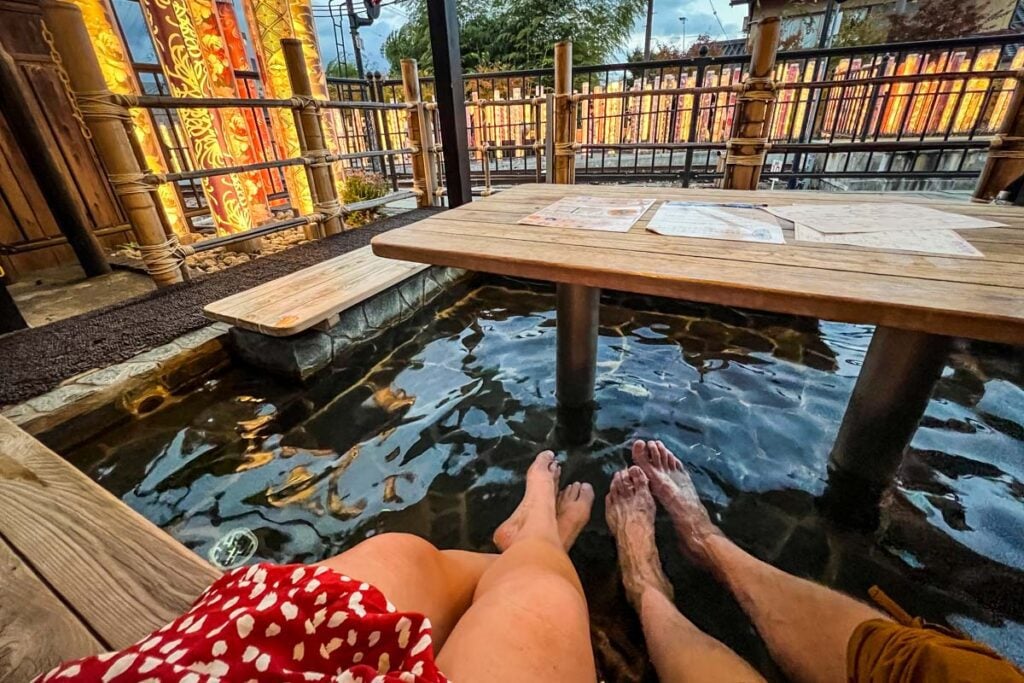
- Soak in a traditional hot spring at one of the public bath houses, or find a ryokan with an onsen that is open to day-trippers.
- Hit the trails and enjoy alpine scenery, mountaintop temples, and observation decks with sweeping views.
- Treat your feet at Taiko no Ashiyu. This foot bath is free to use and is said to help with bruises as well as muscle and joint pain – especially nice after a hike!
- Enjoy the serenity of Atagoyama Park, with plum trees blooming in early spring, magnolias in early April, and a viewpoint overlooking the steamy hot spring town.
- Find the waterfall in Tsuzumigataki Park, named for the sound’s resemblance to the beating of a small drum.
- Stroll along Taiko-dori, the town’s main street lined with cute shops.
How to get there
By train: From Shin-Osaka Station, take the Tokaido-Sanyo Shinkansen Hikari 591 Hikari Hakata to Shin-Kobe Station. Next, take the Hokushin Line to Tanigami Station. From there, take the Kobe-Dentetsu Arima Line to Arimaonsen Station.
Note: the last leg of this journey from Tanigami to Arimaonsen Station is not covered by the JR pass and costs about ¥410 (~$2.75 USD).
By car: The drive from Osaka to Arima Onsen takes a little over half an hour and is pretty straightforward. Take Route 11 northbound out of Osaka and exit Ikeda toward Chugoku Expressway. Continue onto National Route 176.
At the interchange Nishinomiya-Yamaguchi JCT, follow signs for Hanshin Expressway No.7 Kitakobe Route toward Central Kobe. Continue onto Route 7, then take exit Nishinomiyayamaguchi-Minami toward Arima Onsen. Continue straight on 98 to your destination.
By guided tour: On this full-day tour, a visit to Arima Onsen is bookended with the iconic Himeji Castle and Mount Rokko (#4 and #14 on this list of day trips from Osaka). Note that entry to the hot spring is not included in the booking fee.
9. Takeda Castle ruins
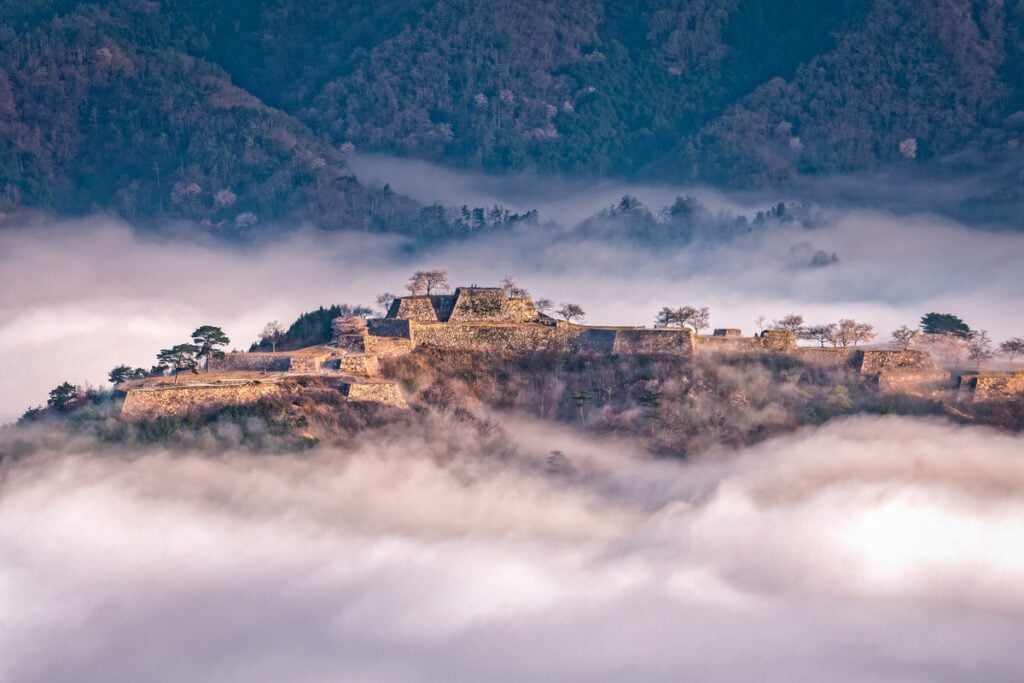
- At a glance: Mountaintop archaeological site that appears to float amongst the clouds
- Distance from Osaka: 126 km / 78.3 miles
- Time: 2 hour 31 minute train ride / 1 hour 46 minutes driving
When the fog rolls in on Takeda Castle on early autumn mornings, the mountaintop ruins appear to float amongst the clouds, giving it the nickname of “Castle in the Sky”.
Also known as “Japan’s Machu Picchu”, Takeda Castle was originally built in 1411 and abandoned in the early 1600s. No buildings are left standing, but the foundations were restored in the 1970s-80s and opened for tourism.
Walking around the stone foundations gives you a good idea of the castle’s layout while treating you to panoramic mountain vistas.
To see the famous illusion of the floating castle, your best bet is a sunrise visit in October or November. The most popular view is from Ritsuunkyo, about a 10-minute drive from Asago town center. From the parking lot, hike 10-40 minutes up the trail to observation decks 1 and 2 for the best views.
Top things to do in Takeda Castle ruins
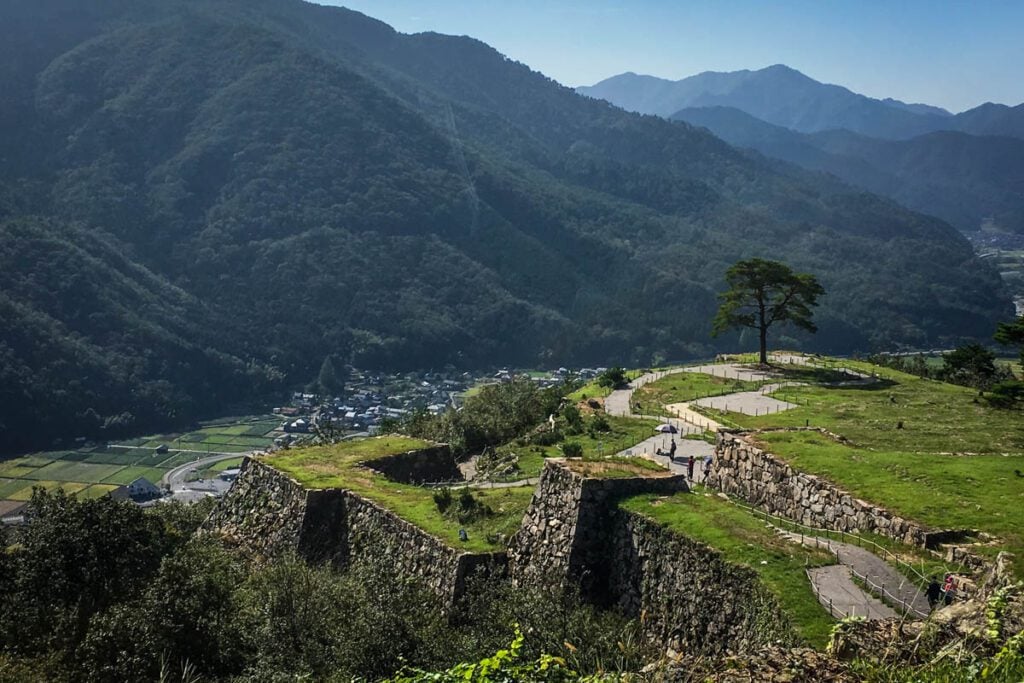
- View the famous “floating castle in the sky” from the Ritsuunkyo viewpoints on the mountain slopes opposite the ruins. The sea of clouds appears about once every 3 days on early autumn mornings. Visitors are asked to pay a ¥300 environmental fee (~$2 USD).
- Hike the scenic trails from Takeda Station to the mountaintop castle.
- Explore the castle ruins and enjoy majestic mountain views. Note that the ruins are closed to the public in January and February.
How to get there
By train: Take the Tokaido-Sanyo Shinkansen from Shin-Osaka Station to Himeji Station, then transfer to Hamakaze 1 Limited Express Tottori to Takeda Station. From there you can take a bus to the castle ruins, but it’s quicker to take a taxi. If you’re feeling adventurous, you can hike up to the ruins on one of two trails behind Takeda Station.
By car: Take Route 11 northbound out of Osaka and get on the Chugoku Expressway. At the interchange Yokawa JCT, follow signs for Maizuru Wakasa Expressway toward Sanda-Nishi/Maizuru.
Stay on Expressway 27 until Kasuga Interchange, then continue onto Kitakinki Toyooka Expressway. Take exit Wadayama IC for Bantan Road toward Asago/Himeji. Follow signs for Route 312 and continue to your destination.
10. Lake Biwa
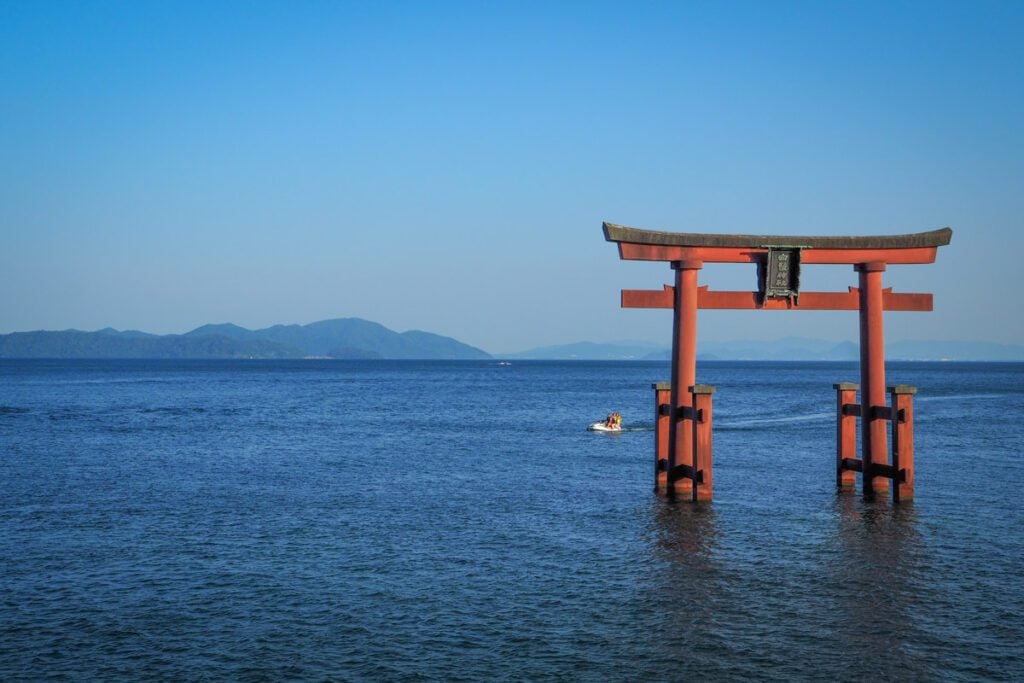
- At a glance: Largest lake in Japan with diverse ecosystem and unique lake culture
- Distance from Osaka: 63.8 km / 39.6 miles
- Time: 52 minute train ride / 53 minutes driving
Note: There are multiple towns around Lake Biwa you can visit, and time and distance from Osaka depend on which city you’re visiting. The above info is for Otsu, the closest Lake Biwa town to Osaka.
As Japan’s largest freshwater lake, Lake Biwa has 235 km (146 miles) of coastline with multiple towns and islands to explore.
Trying to narrow down what to do on a day trip can be overwhelming, but if you choose your activities carefully, it’s possible to combine a few in a day trip. It’s also easy to navigate from town to town, with JR rails encircling the entire lake.
Top things to do in Lake Biwa

- Get out on the water in Otsu. At the BSC Watersports Center, you can rent canoes, kayaks, or SUPs, or learn to sail or windsurf. Or, for something more relaxing, try a leisurely lake cruise.
- Have a beach day at Omi-Maiko. This 4-kilometer (2.5-mile) stretch of white sand is a popular spot in the summer for swimming, windsurfing, or lounging in the shade of the whispering pine trees.
- Spot the famous “floating” torii gate at Shirahige Shrine.
- Take a ferry to Chikubu Island. This sacred island with both a Buddhist temple and a Shinto shrine is known as “the Island of the Gods”. Each spiritual site has a different ritual that is said to bring good luck.
- Get your adrenaline pumping at Biwako Valley, a popular ski resort with breathtaking lake views. If you’re visiting in the summer, go for the views and ziplining, or try their “Skywalker” rope course.
- Explore the old town of Omihachiman, a former merchant hub on the ancient Nakasendo road connecting Tokyo and Kyoto. The well-preserved town features a picturesque canal and offers a glimpse into Japan’s feudal history.
- Visit Hikone Castle. The hilltop keep overlooking the lake has survived since 1622 and is one of only 5 castles in Japan listed as National Treasures.
- Wander the Mizunomori Water Botanical Garden. With a name meaning “water forest”, Mizu-no-mori displays aquatic plants in a tranquil setting. The Lotus Pavilion is the star of the show, where you can even try lotus-flavored ice cream or udon.
- Discover the Lake Biwa Museum and learn about the area’s history and wildlife through a series of interactive exhibits. Bilingual tours are available.
For a day trip from Osaka, we recommend focusing on one region of Lake Biwa and choosing 2-3 things to do in that area. So let’s break this down by region.
South Lake Biwa

Otsu, Moriyama
Situated in the southwest corner of Lake Biwa and just a 20-minute train ride from Kyoto Station, Otsu is the capital and largest city of Shiga Prefecture. Otsu is home to Mt. Hiei Enryakuji Temple, a UNESCO World Heritage Site with a famous “floating” hall built over the water. Otsu is also the location of the Lake Biwa Fireworks Festival and a hub for water sports and lake cruises.
Moriyama is home to the Lake Biwa Museum and Mizunomori Water Botanical Garden. You can get from Otsu to Moriyama by the Ishiyama Sakamoto Line and the Tokaido-Sanyo Line.
West Lake Biwa
Shirahige Shrine, Omimaiko Beach, Biwako Valley
Some of the top sights on Lake Biwa are found on the west side between Otsu and Takashima. The JR Kosei Line runs right up the western shore from Otsukyo Station, granting easy access to all points of interest.
Get off at Omi-Maiko Station (30 minutes from Otsukyo Station) for the popular Omimaiko Beach or Omi-Takashima Station to get to Shirahige Shrine.
For Biwako Valley, take the Kosei Line to Shiga Station and make your way to the Biwako Valley Ropeway.
North Lake Biwa

Takashima, Nagahama, Chikubu Island
The Kosei Line from Otsu stops in Takashima and continues to Omi-Shiotsu Station, where you can transfer to the Hokuriku Line to Nagahama. Ferries run from Nagahama to Chikubu Island.
Alternatively, you can go the more adventurous route of crossing the lake by cruise from Takashima to Nagahama by way of Chibuku Island.
East Lake Biwa
Hikone, Omihachiman
From Otsu, transfer from the Ishiyama Sakamoto Line to the Tokaido-Sanyo Line, which makes stops in both Omihachiman and Hikone.
How to get there
By train: Take the Tokaido-Sanyo Shinkansen from Shin-Osaka Station to Kyoto Station. Transfer to the Kosei Line to Otsukyo Station.
By car: Follow the Meishin Expressway to Kyoto-higashi Interchange. At the interchange, you can take Route 161 up the western side of Lake Biwa, where you’ll find Omimaiko Beach and Shirahige Shrine.
Alternatively, take Route 1 to head toward Otsu. Off Route 1, Route 559 hugs the eastern shore of the lake and Mizunomori Water Botanical Garden, Fujigasakiryu Shrine, and Hikone Harbor.
By guided tour: New to Get Your Guide, this tour offers round-trip transportation from Osaka or Kyoto to the Miho Museum, Kyu-Chikurin-in, and Lake Biwa. Explore the Shirahige Shrine and its iconic torii gate that stands in the lake.
11. Ikeda
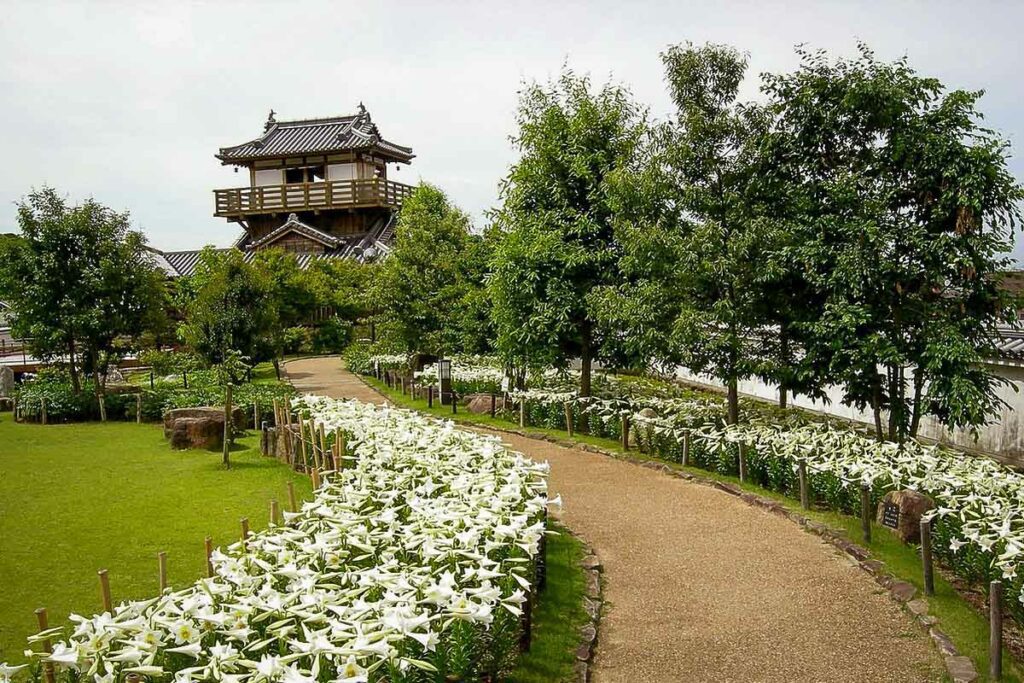
- At a glance: Historic city with green space and quirky attractions off the typical tourist path
- Distance from Osaka: 21.1 km / 13.1 miles
- Time: 29 minute train ride / 22 minutes driving
Often overlooked by visitors to Osaka, Ikeda makes for a fun and easy day trip with less tourist traffic.
A day trip to Ikeda offers cultural experiences with Edo-period entertainment arts, such as rakugo (comedic storytelling) and kabuki. You can see performances at the Rakugo Museum and Gofukuza Theater, respectively (but know that they’ll be performed in Japanese).
One of the coolest things to do in Ikeda is a visit to the Cupnoodles Museum, where you’ll learn all about the history and science of the globally-beloved convenience food. The museum features a tasting room with vending machines selling limited and rare flavors, as well as two “factories” where you can get creative and craft your own personalized cup of instant noodles or chicken ramen.
There are also opportunities for nature escapes in Ikeda, with parks, gardens, and hiking trails. Spring and autumn are especially beautiful times to visit to see cherry blossoms and fall foliage.
Top things to do in Ikeda

- Make your own instant noodles at the Cupnoodles Museum. Design your own cup and choose from a variety of soup flavors and toppings to create your own personalized product (and a unique souvenir to take home!).
- Hours: opens at 9:30 a.m. with last admission at 3:30 p.m. Closed on Tuesdays and holidays.
- Admission: entrance to the museum is free. To make your own noodles costs ¥500 per cup, while the Chicken Ramen Factory is ¥1,000 per person. Reservations are required only for the Chicken Ramen Factory.
- Stroll Satsukiyama Park. Stretching halfway up Mt. Satsuki, the symbol of Ikeda, this park boasts hiking trails and an observation tower that offers sweeping views of Osaka. The park is also a popular spot for hanami (flower-viewing) with sakura in the spring and azaleas, (the official flower of Ikeda, in May.
- Visit Ikeda Shiroato Park, where you can see the remaining ruins of the original Ikeda Castle, as well as the reconstructed main keep.
- See a traditional Japanese performance of kabuki or rakugo at Gofukuza Theater or the Rakugo Museum.
- Catch a show by the Takarazuka Revue, an all-female theater troupe that performs Broadway-style productions at the Takarazuka Grand Theater, just a 30-minute train ride from downtown Ikeda.
How to get there
By train: Take the Takarazuka Main Line from Osaka-Umeda to Ikeda Station.
By car: Stay on Route 11 heading north, then take Kawanishi-Obana toward Gofukubashi/National Route 176/Prefectural Route 13 and continue on Route 176 to Ikeda.
12. Uji

- At a glance: Picturesque riverside town known for its green tea
- Distance from Osaka: 45.1 km / 28 miles
- Time: 1 hour train ride / 47 minutes driving
Nestled between the more popular tourist destinations of Kyoto and Nara (#1 and #3 on this list), Uji makes a great choice for a day trip if you want a break from the big city crowds.
Uji is renowned for producing premium green tea of unmatched quality. You can take your pick of restaurants, traditional tea houses, and shops to taste the coveted drink, as well as a variety of matcha-flavored snacks and sweets, such as soba and ice cream. One place to try is Tseun, Japan’s oldest tea shop since 1160, which serves green tea parfaits and rice dumplings.
Aside from tea, Uji is most famous for its iconic Byodoin Temple. Built in 998, this UNESCO World Heritage Site is a stunning display of Buddhist Pure Land architecture surrounded by serene reflective ponds. The highlight is Phoenix Hall, which you might recognize if you have a ¥10 coin in your pocket.
The tranquil Uji River gently bisects the town. Lined with weeping willows, lush foliage, and cute shops, the riverfront is a lovely place for stroll. Be sure to stop at Uji Bridge, one of Japan’s oldest (though it has been destroyed and rebuilt several times). The bridge is famously connected to one of Japan’s most important literary works, the 11th-century novel The Tale of Genji.
Top things to do in Uji

- Join a traditional tea ceremony at Taihoan tea house. The experience only costs ¥1,000 (about $7 USD) and includes a bowl of matcha and a Japanese sweet.
- Grind your own matcha at Fukujuen Ujicha Kobo workshop.
- Tour the famous Phoenix Hall at Byodoin Temple. Having never been destroyed by fire or other disasters, Phoenix Hall is one of few surviving Heian-period wooden structures. You can tour Byodoin Temple for ¥600 (~$4 USD) and Phoenix Hall for an additional ¥300.
- Cruise or stroll the Uji River.
- Visit Ujigami Shrine, thought to be Japan’s oldest standing shrine.
- Explore Mimurotoji, known as the “flower temple” due to its beautiful gardens.
How to get there
By train: Take the Tokaido-Sanyo Shinkansen from Shin-Osaka Station to Kyoto Station. Transfer to the Nara Line to Uji Station.
By car: Follow Route 12 northeast out of Osaka. At Moriguchi JCT, follow signs for Kinki Expressway toward Daini Keihan Road. Stay on Kinki Expressway to Kadoma JCT and follow signs for Dainikeihan Expy/Hirakata/Kyoto City. Continue on Route 1. At Kumiyama JCT, follow signs for Keiji Bypass toward Meishin Expressway/Nagoya/Uji, then take exit Uji-nishi IC. Get on 241 and continue to Uji.
By guided tour: Visit Uji on this World Heritage Sites day tour. After experiencing the highlights of Kyoto (#1 on this list of day trips from Osaka), your guide will take you to Uji to explore the famous Byodoin Temple.
13. Wakayama

- At a glance: Sacred sites, beautiful beaches, and a unique local ramen style
- Distance from Osaka: 78.6 km / 48.8 miles
- Time: 1 hour 16 minute train ride / 1 hour 10 minutes driving
Enveloping the end of the Kii Peninsula, Wakayama Prefecture is known as the “Kingdom of Fruit” for the number of farms and orchards within its borders. With around 600 km (~373 miles) of coastline, the area is also famous for seafood and beaches, while the presence of Koyasan and Kumano-Kodo (#6 on this list) make it an important spiritual destination as well.
The prefecture’s capital is Wakayama City, strategically built on Wakaura Bay to protect western Japan against attacks from the east. A day trip to Wakayama City offers a mix of culture, history, modern attractions, and culinary adventures.
Top things to do in Wakayama

- Visit the iconic Wakayama Castle. Originally built in 1585, this strategic fortress still retains its original moat and stone wall, the rest having been destroyed in WWII and reconstructed. The hilltop tower offers panoramic views over the city, and 600 or so cherry trees display breathtaking blossoms in the spring.
- Wander Momijidani Teien Garden. Next to Wakayama Castle, this Edo-period garden is named for its maple leaves that turn bright red in autumn. There’s also a teahouse within the garden, where visitors can enjoy traditional Kishu tea and sweets.
- Take the ferry to the nearby islands of Tomogashima. The overgrown ruins of an abandoned military fort create a hauntingly beautiful scene, famous for its resemblance to the floating island in Studio Ghibli’s Castle in the Sky.
- See the unique Awashima-jinja Shrine. Dolls dedicated from all over Japan fill the front hall of this colorful seaside shrine where women come to pray in the March 3rd Hina Nagashi ritual.
- Explore Marina City, a man-made resort island in Wakaura Bay featuring a European theme park along with waterfront shopping and dining. Visit Kuroshio Market for just-caught seafood, or Kinokuni Fruit Village for fresh produce from local Wakayama farmers.
- Get a view from Tosho-gu Shrine and Kimii-dera Temple.
- Pick fresh fruit at one of Wakayama’s orchards.
- Have a beach day.
- Bonus: sample soy sauce where it originated. A 40-minute train ride on the Kisei Main Line will bring you to the picturesque town of Yuasa, the birthplace of the beloved salty condiment. Tour a factory and, if you’re feeling adventurous, try the soy sauce ice cream.
How to get there
By train: From Osaka Station, take the JR Kuroshio line #7 Limited Express Shirahama to Wakayama Station. From there, it’s about a half hour walk to the city center, or you can take a local bus for only ¥230 – less than $2 USD.
By car: Follow Route 16 onto Route 4 heading southwest along Osaka Bay. At Rinko JCT, follow signs for Hanwa Expressway and get on Kansai Airport Expressway. At Izumisano JCT, follow signs for Hanwa Expressway toward Sennan/Wakayama, then take exit Wakayama IC.
14. Nagoya
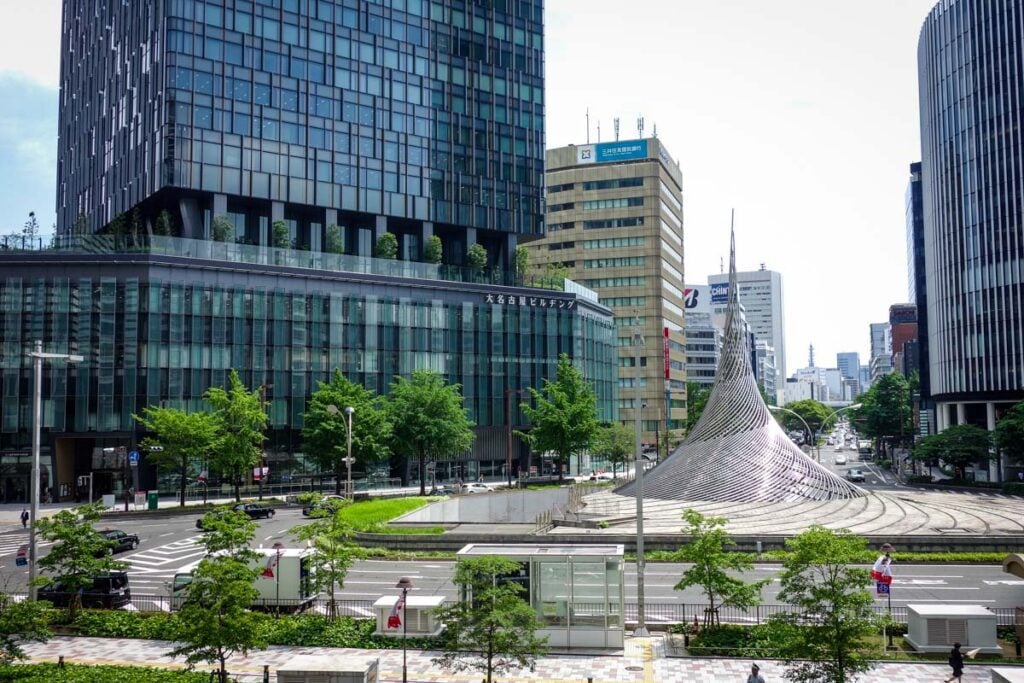
- At a glance: Urban center and transportation hub that combines history and industry
- Distance from Osaka: 173 km / 107.5 miles
- Time: 50 minute train ride / 2 hours 15 minutes driving
Located in the heart of Japan, Nagoya is the country’s 4th most populous city, an industrial center, and one of Japan’s most important transportation hubs.
The city developed around Nagoya Castle, originally built in 1610. Sadly, along with most of the city’s historic buildings, the castle was destroyed during the 1945 air raids. A reconstruction now stands in its place.
Nagoya’s culture of industry and manufacturing can be seen at the Toyota Commemorative Museum of Industry and Technology and the SCMAGLEV & Railway Park, a museum that showcases rail history from steam to levitating maglev trains where you can see retired trains and try your hand at a simulator.
Top things to do in Nagoya

- Admire Nagoya Castle & Meijo Park. One of the biggest castles in Japan sits within a public park known for its May wisteria blooms.
- Important Note: The castle is scheduled to be torn down in 2024 and rebuilt with wood for greater historical accuracy. Visitors cannot currently enter the castle keep because it isn’t up to earthquake safety standards.
- Try Hitsumabushi, a Nagoya specialty where unagi (freshwater eel) is eaten in a specific four-step process with certain sides and condiments.
- Discover the Toyota Commemorative Museum of Industry and Technology. Learn the history of the auto manufacturing giant through interactive exhibits and see cars on display. English audio guides are available for ¥200 or via a free app.
- General admission: ¥500 (~$3 USD)
- Space out at the Nagoya City Science Museum, home to one of the world’s largest planetariums.
- Touch the sky at Midland Square, Nagoya’s tallest building. The Sky Promenade on the top three floors is one of the highest open-air rooftop observation facilities in Japan and offers uninterrupted views of the city. The rest of the building houses offices, restaurants, high-end shopping, special events, and a cinema.
- Take the fam to Legoland or Nagashima Resort. The colorful themed attractions at Legoland are perfect for families with young kids, while there’s something for everyone at Nagashima Resort, an amusement park with rides, a water park, onsens, shopping, and a flower park.
How to get there
By train: Easy-peasy – take the Tokaido-Sanyo Shinkansen from Shin-Osaka Station all the way to Nagoya Station.
By car: Take Route 11 onto Meishin Expressway, following signs for Kyoto. At Kusatsu JCT, continue onto Shin-Meishin Expressway toward Kusatsu-Tanakami IC/Higashi Meihan Expressway/Shigaraki/Kameyama/Ise Expressway. Then at Kameyama-nishi JCT, take the right fork onto Kinki Expressway. At Yokkaichi JCT, follow signs for Higashi-Meihan Expressway toward Nagoya. After about 24 km, this road becomes Route 5 and continues to Nagoya.
15. Mt. Rokko

- At a glance: Accessible mountain peak known for its natural beauty and stunning views
- Distance from Osaka: 34.6 km / 21.5 miles
- Time: 1 hour 20-45 minute train ride / 44 minutes driving
Just north of Kobe, Mt. Rokko is the highest peak in the mountain range of the same name. From 931.3 meters (3,055 feet), the peak offers panoramic vistas over Kobe and Osaka. Seeing Kobe lit up below at night is known as the “$10 million view”.
A day trip to Mt. Rokko provides an escape from the city with opportunities for active, outdoor, and relaxing activities.
The mountain is accessible by ropeway (gondola) or an old-school open-air cable car. Both the ropeway and cable car stations, as well as all major tourist attractions on the mountain, are connected by a bus that runs on a loop.
Top things to do in Mt. Rokko
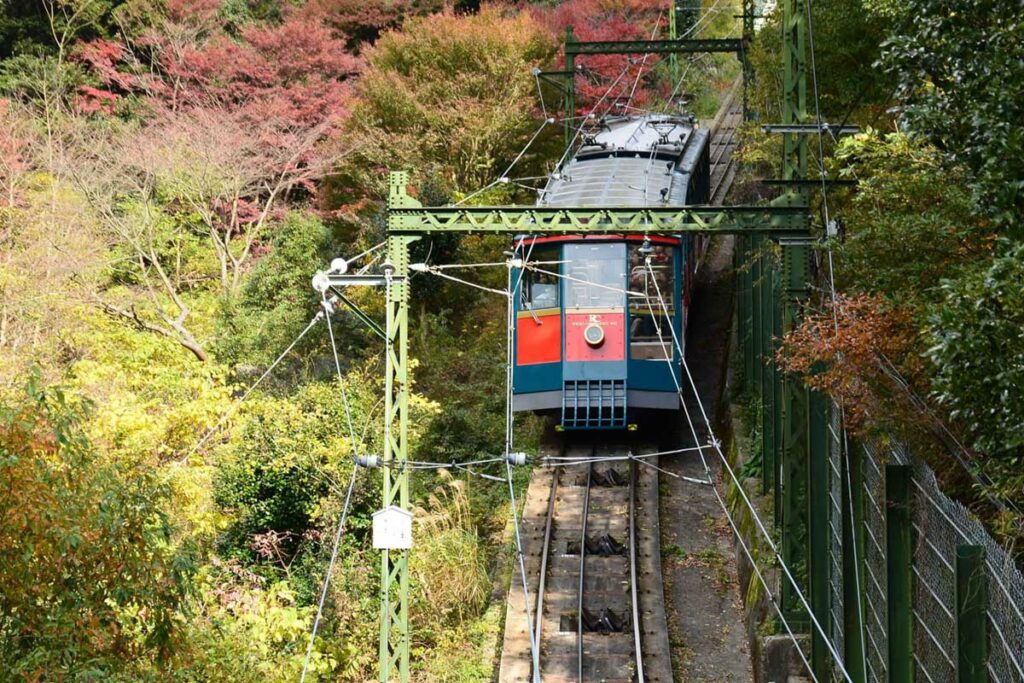
- Ride the scenic ropeway or cable car up to Mt. Rokko.
- Take in views from the Rokko Garden Terrace or the observation deck next to the cable car platform.
- Wander the Rokko Alpine Botanical Garden. The garden is open March – November with cherry blossoms in the spring, summer wildflowers, and colorful fall foliage. Adult admission is ¥900, about $6 USD.
- Play a round at Japan’s first golf course. The Kobe Golf Club was established in 1903 by a British expat and is now a full 18-hole course.
- Discover the Rokko Morione Museum. This quirky museum displays a collection of music boxes and other mechanical instruments and offers unique experiences, such as “concerts without performers”, a “sound walkway” through a tranquil garden, and a make-your-own music box workshop. General admission is ¥1,500 (~$10 USD), some experiences may cost extra.
- Have fun at Rokko Snow Park (early December – early March). With slopes for skiing/snowboarding and a separate, child-friendly sled hill, this makes a great family activity.
- General admission: ¥2,500 (~$16 USD)
- Lift pass: ¥1,600 weekday pass (~$11 USD), ¥3,300 weekend day pass (~$22 USD), ¥250 single-lift ticket (~$1.70 USD)
- Rental fees extra
How to get there
By train: There’s no direct train line from Osaka to Mt. Rokko, but getting there is an experience in itself. Choose one route for the trip there and the other for return to experience both the cable car and ropeway.
- Cable car: Take the Tokaido-Sanyo Line Rapid Himeji from Osaka Station to Rokkomichi Station. Walk 1 minute to the JR Rokkomichi bus station and catch the #16 bus to Rokko Cable Shita. Walk 1 minute to Rokko Cable Shita Station and take the cable car to Rokko Sanjo Station.
- Ropeway: Take the Kobe Line Limited Express Shinkaichi from Osaka-Umeda Station to Shukugawa Station. Walk to the adjacent bus station, Hankyu Shukugawa, and take Arima Route (A23) Narai to Arima Onsen Hot Springs. Walk 20 minutes (or take a taxi) to the Rokkoarima Ropeway station (also called Arima Onsen Station – confusing). A scenic gondola will take you up to Mt. Rokko.
Once you arrive at either the cable car or ropeway station on Mt. Rokko, you can use the local Rokko Sanjo Bus to get to all the major attractions.
By car: Take the Hanshin Expressway toward Kobe. Exit onto Route 43 at the Ashiya toll gate. After about 1.7 km, turn right, then turn left on Route 2. Turn right at Narihira Bashi Hashizume intersection onto 344, following signs for Arima/Royu Rd. Continue onto Royu Driveway. Turn right at Hoden Toll Gate (before the tunnel). Keep left after the toll to head south on 16 and continue to Mt. Rokko.
By guided tour: This full-day sightseeing tour includes stops at Himeji Castle and Arima Onsen (#4 and #7 on this list of day trips from Osaka) before enjoying panoramic views from the enchanting Mount Rokko.
16. Awaji Island
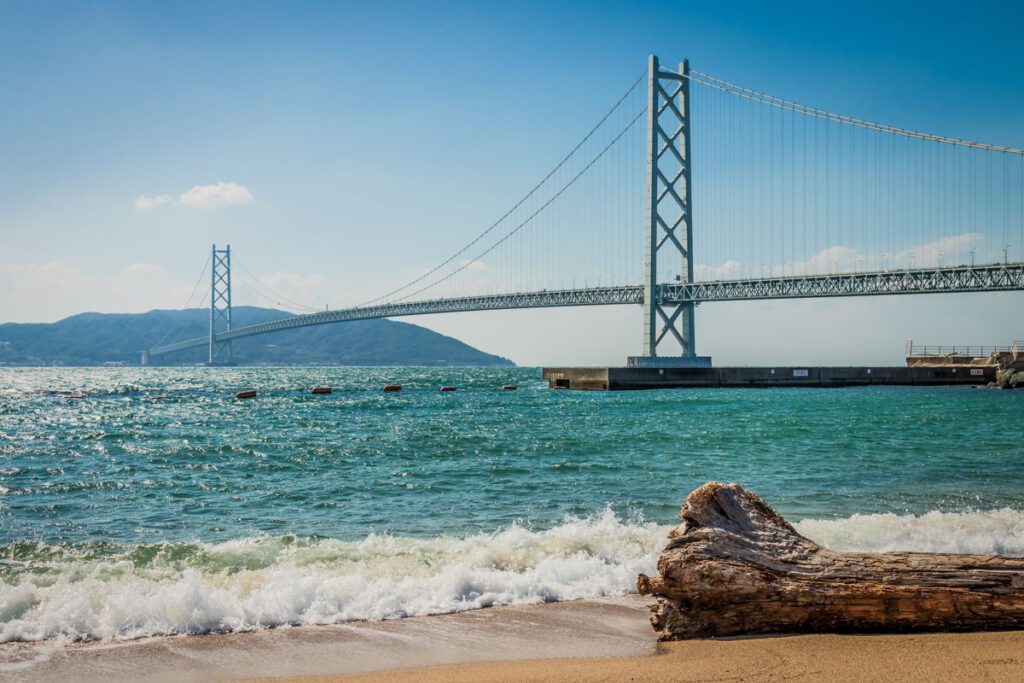
- At a glance: Island escape known for hot springs and gourmet cuisine
- Distance from Osaka: 102 km / 63.4 miles
- Time: 1 hour 52 minute train ride / 1 hour 19 minutes driving
Situated between the islands of Honshu and Shikoku in Japan’s Seto Inland Sea, Awaji-shima is a relatively small island with a long, eclectic list of claims to fame. From history to mythology, whirlpools to hot springs, puppets to onions, travelers of all kinds can surely find something to interest them on Awaji Island.
Legend says that Awaji was the first island in Japan to be created by the Shinto gods, and you can see the creation myth reflected around the island. One example is in Awaji’s longstanding history of puppetry, which is said to have begun as entertainment for the gods’ children.
Awaji Island is also known as “the region of food” and has historically produced gourmet foods for the Imperial Court. Fresh seafood and marbled beef are among the island’s proudest delicacies.
Then there are the onions. Awaji’s mineral-rich soil provides the perfect environment for growing some of the sweetest onions on the market. It’s a whole thing; besides tasting the famed bulbs, tourists can snap a photo of a giant onion statue, or snatch up a fresh one in an onion UFO game (the arcade game with the claw, y’know?).
Top things to do in Awaji Island

- Relax in the island’s hot springs. The most famous are the Minamiawaji Hotspring District and Sumoto Hotspring. Check first to make sure your chosen hotspring accommodates day trips, as some are reserved for overnight guests.
- Sample the local cuisine, such as Awaji beef, fresh seafood, or—you guessed it—onions.
- See the famous Naruto Vortex, a huge natural whirlpool between Awaji and Shikoku Island.
- Visit Hokudan Earthquake Memorial Park, the epicenter of the 1995 Great Hanshin Awaji Earthquake. The park features a museum and an earthquake simulator, as well as a preserved section of the fault line that was displaced by the 1995 quake.
- Stop at Izanagi Jingu Shrine, believed to be the oldest Shinto shrine in Japan.
- Enjoy a traditional Ningyo Joruri performance at the historic Awaji Puppet Theater.
- Cross the Akashi Kaikyo Bridge that connects Awaji and Kobe. From its completion in 1998 until 2022, this feat of engineering held the title of the world’s longest suspension bridge.
How to get there
By train: Take the Tokaido-Sanyo Line Special Rapid Himeji from Osaka Station to Sannomiya Station. Walk 3 minutes to Shinki Bus Kobe Sannomiya Bus Terminal. Then take the Kobe – Fukuri bus [Minami Awajishi] to Midori PA on Awaji Island.
By car: Take the Hanshin Expressway No. 3 toward Kobe. At Myodani JCT, follow signs for Akashi Brg/Kitasen Rd/Myodani/Tarumi/Myodani IC/Tokushima/Sanyo Expressway.
At Tarumi JCT, follow signs onto Kobe Awaji Naruto Expressway toward Tokushima and continue to Awaji Island.
By guided tour: On this new tour from Get Your Guide, you’ll have a chance to explore the natural beauty and landmarks of Awaji Island, as well as the Naruto Whirlpools and the city of Kobe (#5 on this list of day trips from Osaka).
How to get to these day trips from Osaka
Getting to and from Osaka to visit these places takes a bit of pre-planning, but you have a few different options for transportation.
Traveling around Japan by train

Japan’s railway system is known around the world for being clean, fast, and efficient. Between the famous Shinkansen bullet trains, regional rails, and local metros, most of the major tourist destinations in Japan are accessible by train.
The only major downfall about the trains in Japan is that a single ride can be expensive. Depending on where you’re going, it can be very expensive.
But you know us; we love finding sneaky ways to travel (even notoriously expensive countries) on a budget. And we love sharing our secrets with you, so here it is: our VERY detailed guide to train travel in Japan.
Want more tips on traveling Japan on a budget? We have a few practical money-saving tricks up our sleeves that you’ll definitely want to save!
Getting a rental car in Osaka

Having your own vehicle when visiting Japan will give you a lot more freedom to explore the best day trips from Osaka.
We personally like using Booking.com (formerly RentalCars.com) when we rent vehicles around the world, as they gather options from all sorts of rental companies in one place. It makes it really easy to compare prices and vehicles so you can determine which is the best option for you.
Before you book, be sure to read our guide to renting a car in Japan. It’s packed with things you need to know before you get behind the wheel, as well as insider tips to help you feel confident on the road.
More things to do in Osaka
We have an entire article dedicated to the best things to do in Osaka where we share details and tips for making the most of your trip.
First timer’s guide to Osaka
If this is your first time visiting Osaka, you’ll want to read our First Timer’s guide which is packed with helpful information like how to get around and where to find the best eats.
Perfect Osaka itinerary
Want your Osaka itinerary planned for you? No problem! We did the legwork and came up with what we think is the perfect route for a 2-day Osaka itinerary for your first visit.
Plan your trip to Japan
After 3 trips (and counting!), we’ve fallen head over heels for Japan—and we’ve created TONS of resources to help you plan your dream trip. Start with our Ultimate Japan Travel Guide and be sure to check out these helpful articles:
- First time? Our Japan Trip Planner walks you through everything you need to know.
- Use our Japan Rail Pass guide to determine if getting a train pass is optimal for your trip.
- Here’s our curated list of the best things to do in Japan—from iconic sights to once-in-a-lifetime experiences.
- Not sure where to go? Our Japan itinerary ideas will help you map it all out.
- Foodies, rejoice! This guide to what to eat in Japan will have you drooling before you land.
- This guide to what to wear in Japan (and what not to wear) will help you blend in.
- Use our ultimate Japan Packing List to make sure you don’t forget anything.
- Before you go, brush up on these essential Japan travel tips (including major do’s and don’ts!).
- Avoid awkward moments by brushing up on Japanese etiquette.
Still have questions? Drop us a comment—we LOVE helping travelers plan unforgettable trips to Japan!
Perfect Japan itinerary
Want the perfect itinerary planned for you?

If you don’t have a ton of time to spend planning your Japan itinerary (or you just don’t find travel planning fun), we’ve got something you might be interested in…
We created the ultimate done-for-you Japan itinerary that is packed full of all sorts of tips we’ve gathered from 3 trips to Japan as well as literally hundreds of hours of research (no exaggeration).
We have both an off-the-beaten path route as well as a classic itinerary that hits the top attractions (perfect for your first visit to Japan!).
Don’t miss your chance to grab our custom Osaka map!
Get our custom Osaka map sent straight to your phone! We loaded this map with all our favorite restaurants, sights, hidden gems, and more, so you can make the most of your time in Osaka.
Just enter your email and we’ll immediately send you access instructions!
Save this article on Pinterest for later!
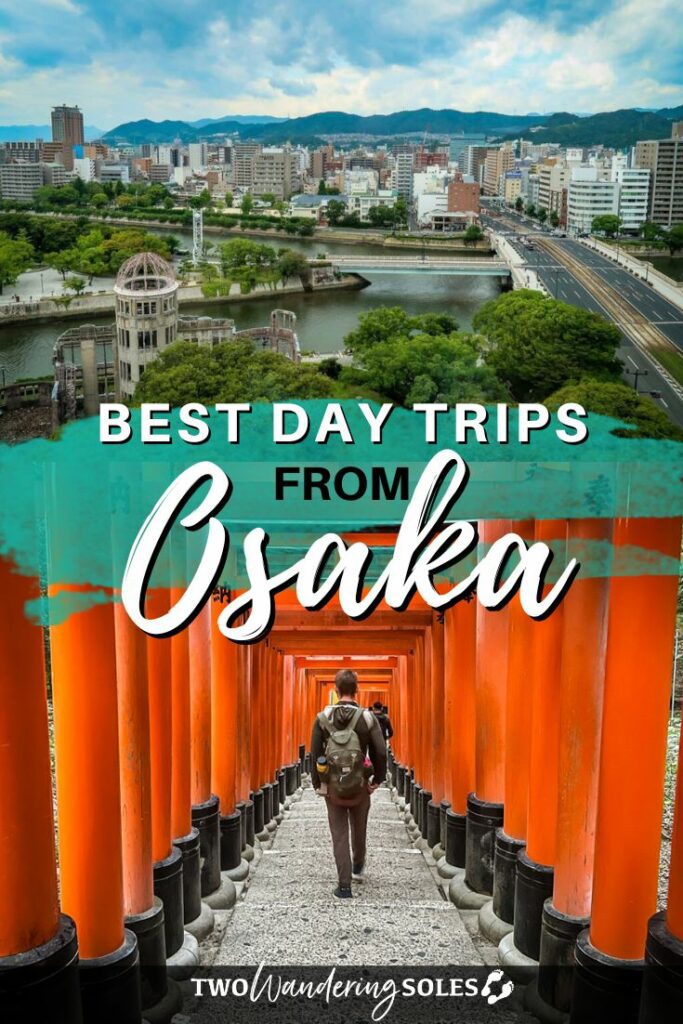
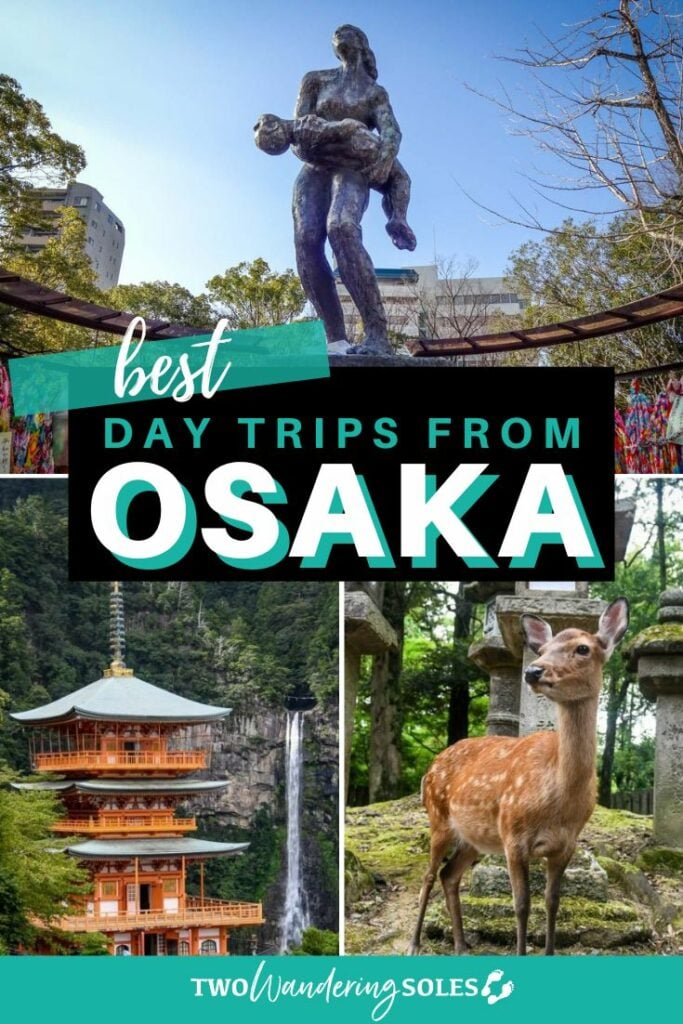
We want to hear from you!
Which of these day trips from Osaka is up your alley? Do you have any suggestions we might have missed? Let us know in the comments below and we’ll do our best to get back to you!

